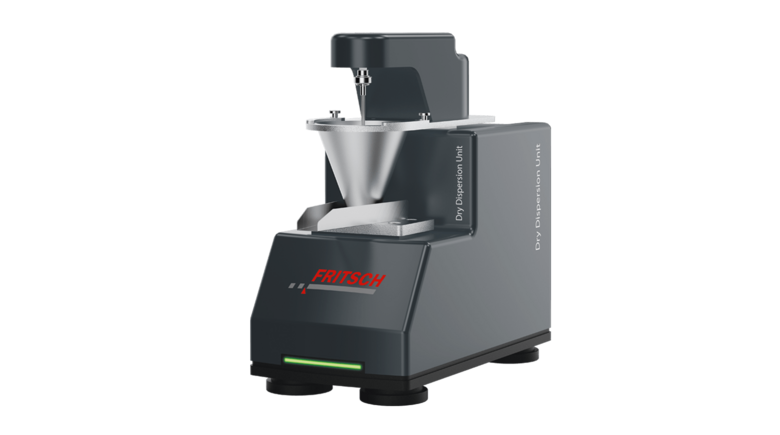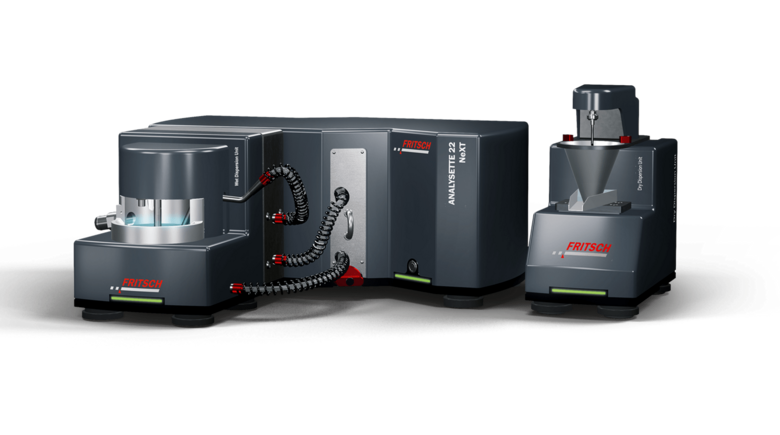-
Reliable thoroughness
The ultra-compact dry dispersion unit with a height-adjustable funnel and a stirrer made of stainless steel ensure optimum sample feeding adapted to the respective sample material.
The sample material is transported with a vibratory feeder through the intake funnel into the dry measuring cell, where it falls directly into a Venturi nozzle operating with an adjustable flow of compressed air. Upon passing through the nozzle, agglomerates are broken up and the measurement of the particle size dispersion in the laser beam takes place directly afterwards. For dry dispersion the required sample volume is 1 – 300 cm3, which is larger compared to wet dispersion; however it is also easier to obtain a representative analysis.
-
Strong advantages during dry measurement
- Fast measurement of powdery samples in an accelerated airflow
- For sample volumes from less than 1 cm3 to approx. 300 cm3
- Efficient degradation of agglomerates with a special Venturi nozzle
- No impact areas – protection against comminution of the particles
- Perfect sample feeding with high frequency feeder
- Automatic computer-controlled adjustment of the dispersion pressure
- Fully automatic, freely programmable measurement processes
- Especially fast and easy to clean - without tools
-
Technical data
Type of dry dispersion Measurement of powdery samples in an accelerated airflow, degradation of agglomerates with compressed air Measuring range 0.5 - 1500 µm (NeXT Micro)0.01* - 3800 µm (NeXT Nano) Minimum dispersible particle size* approx. 1 - 10 µm Sample material characteristics Not too fine, free-flowing materials, which react in water or other liquids Sample volume 1 – 300 cm3 Sample feeding high-frequency feeder Dispersion Venturi nozzle Required compressed air supply min. 5 bar, 125 l/min, oil-free, water-free, particle-free Sample exhaust external exhaust system required Typical measuring time 5 - 10 s (measurement value recording of a single measurement)
2 min (entire measuring cycle)Dimensions (W x D x H) 24 x 45 x 39 cm Weight 17.3 kg *depending on the material -
Dispersion process
The sample material is fed through the height-adjustable funnel and stirrer onto the high-frequency feeder and continuously transported over the funnel-shaped opening of the dry measuring cell and then drops in the actual dispersion area. In a Venturi nozzle the powder is accelerated and passes with a high speed through the nozzle channel and the measurement of the particle size distribution in the laser beam takes place directly behind it. Then it passes a zone with aerodynamic wave generation at the nozzle outlet. The by the high turbulent current caused strong shearing forces, as well as blows between the particles lead to the breakdown of the agglomerates. No impact areas in the flight path of the particles exist in order to prevent soft sample materials from being ground during the dispersion process.
Compared with the wet dispersion is the dry dispersion not as efficient due to chemically-physical as well as rheological material properties of the sample material.
One of the main differences between dry and wet dispersion is based on the fact, that it is almost a solely mechanical dispersion in an air flow. Thereby, with a dry dispersion, a sensible measurable particle size and the associated complete primary particle dispersion is typically at approximately 1 - 10 µm. Depending on the material and its properties, below this range an incomplete dispersion can be expected. The utilization of the dry dispersion makes sense in areas where a wet dispersion in water or solvents has to be ruled out.
-
Fully programmability
The dispersion pressure is set with the assistance of SOP’s with the software MaS control and then is carried out automatically. Measurement processes can therefore be freely programmed and the entire measurement takes place completely automatic.
-
Compressed air connection
For the operation of the dry dispersion unit, an oil-, water- and particle-free supply of compressed air with a pressure of at least 5 bar and an air volume of at least 125 l/min is required. An external exhaust system is necessary to vacuum the sample material and can be ordered as a FRITSCH accessory together with the instrument.
-
Multifunctional exhaust system
The integrated exhaust system of the dry dispersion unit ensures automatic sample exhaust during the measurement. When the measurement is completed it can also be easily used to manually clean the feeder. An external exhaust system is necessary to vacuum the sample material and can be ordered as a FRITSCH accessory together with the instrument.




